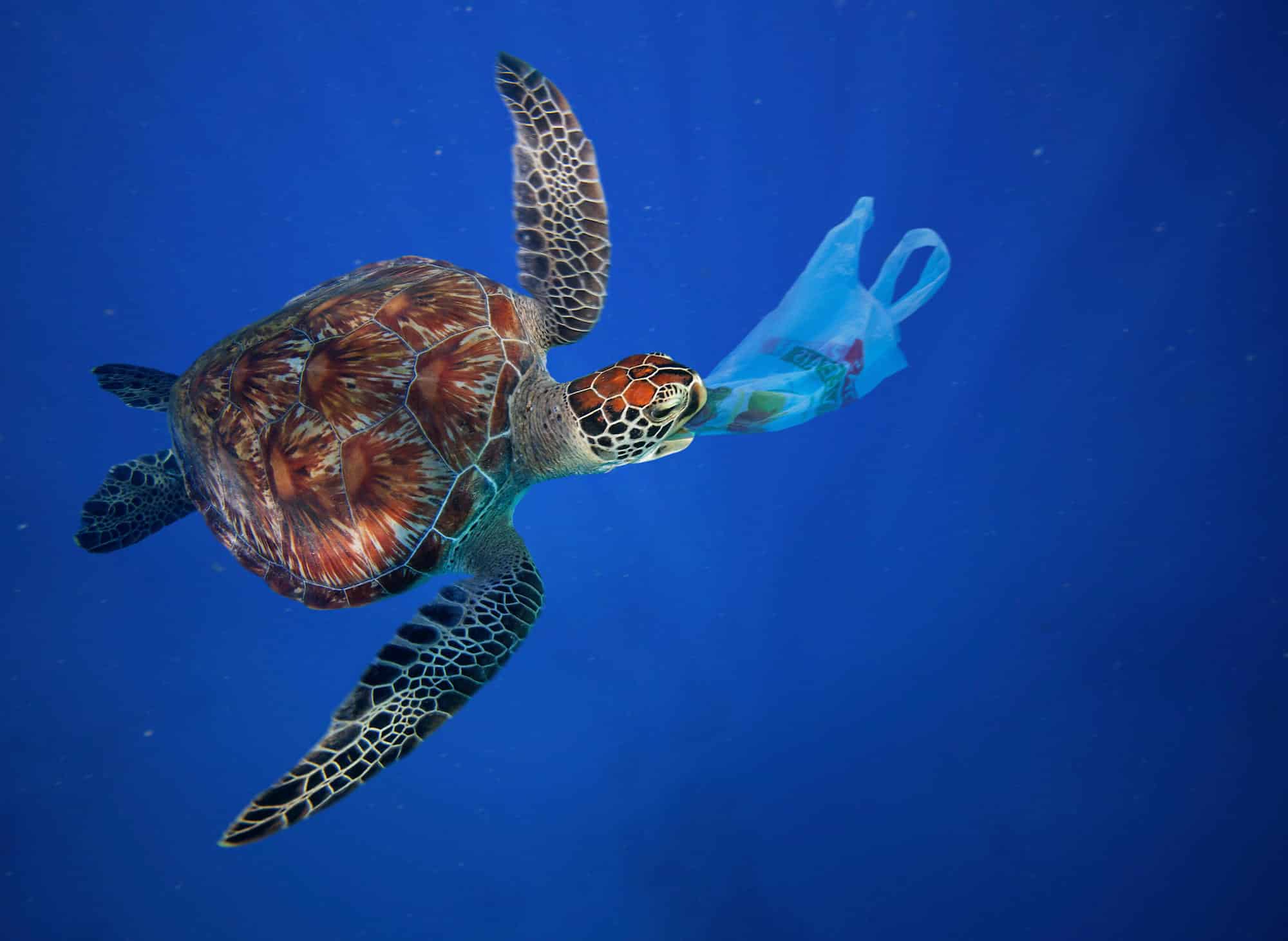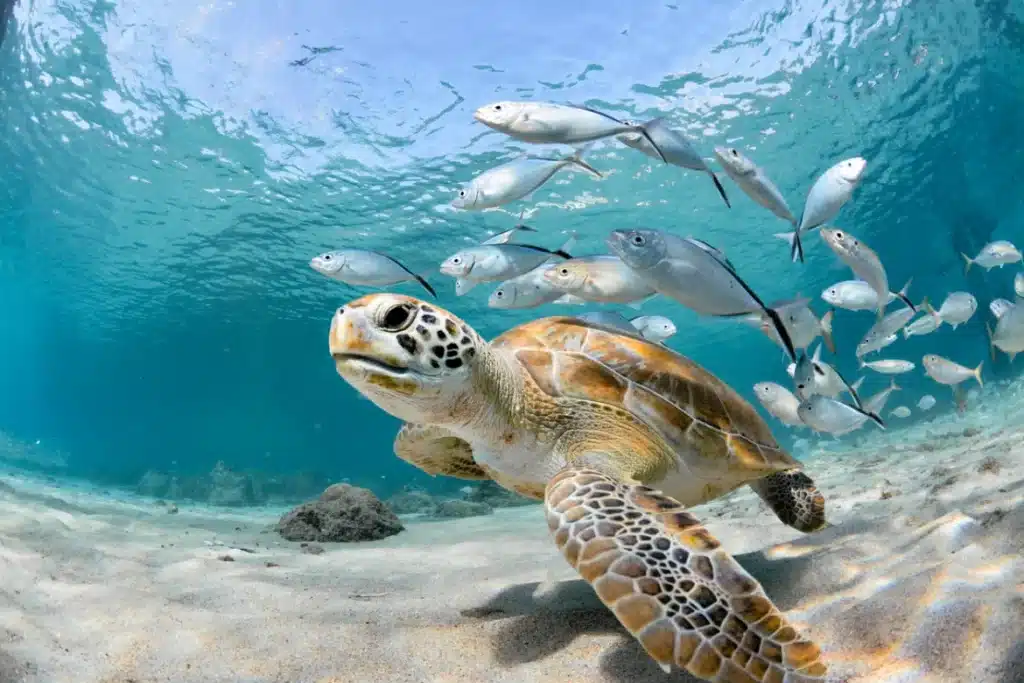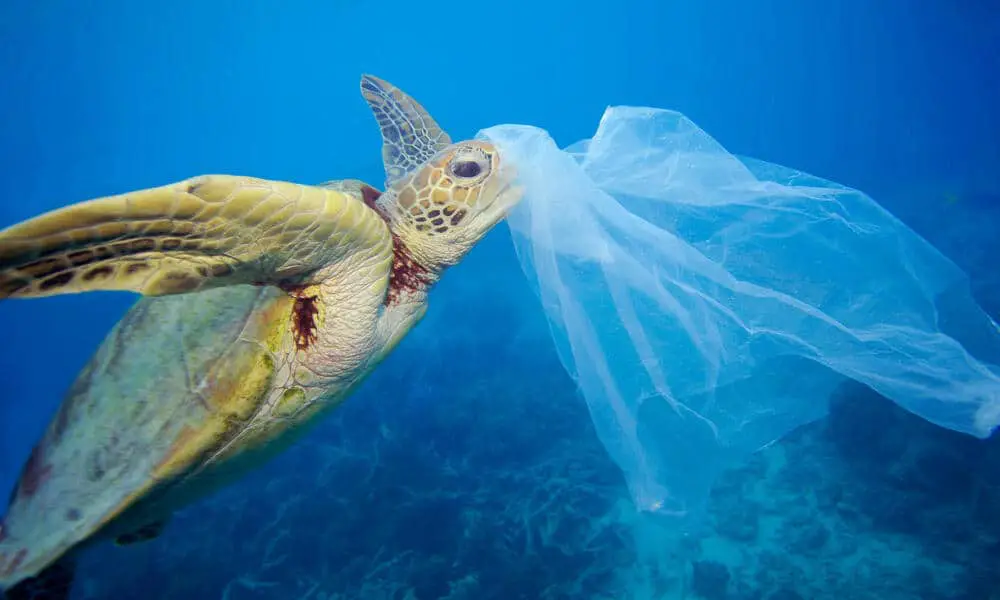How Does Plastic Affect Sea Turtles

Introduction
How Does Plastic Affect Sea Turtles: The world’s oceans are facing an unprecedented environmental crisis – plastic pollution. Among the many victims of this ecological scourge, sea turtles stand out as particularly vulnerable and emblematic. These magnificent creatures, which have graced our planet’s oceans for over 100 million years, are now struggling to survive due to the pervasive presence of plastic debris in their marine habitats.
Plastic pollution affects sea turtles in various devastating ways, posing a grave threat to their populations. These impacts are not only a concern for the turtles themselves but also for the broader marine ecosystem. Understanding the extent of this issue is essential for addressing the conservation challenges that sea turtles face.
This article delves into the multifaceted ways in which plastic pollution affects sea turtles. It explores how these ancient reptiles become entangled in discarded fishing nets and other debris, leading to injury and death. Additionally, the ingestion of plastic items like bags and fragments often occurs, causing internal harm and, in some cases, fatalities.
Moreover, plastic pollution contributes to the degradation of sea turtle nesting habitats and can alter the balance of marine ecosystems on which these creatures depend for their survival. To protect sea turtles and preserve the biodiversity of our oceans, it is imperative that we grasp the full scope of how plastic pollution impacts these remarkable animals.

How many turtles are affected by plastic?
How Many Sea Turtles Die Each Year From Plastic. Documented about 1,000 sea turtles die annually from digesting plastic.
Estimating the exact number of turtles affected by plastic pollution is a complex task, as it varies across species, regions, and timeframes. However, numerous studies and observations indicate that a significant number of sea turtles are indeed impacted by plastic debris. The International Union for Conservation of Nature (IUCN) reports that all seven species of sea turtles are susceptible to the threat of plastic pollution.
Some studies have shown that up to 90% of juvenile green sea turtles in certain areas have ingested plastic, and a substantial number of loggerhead and leatherback turtles have been found entangled in discarded fishing gear. Additionally, plastic pollution affects sea turtle nesting habitats, altering the sand composition and temperature, which can impact hatchling success rates.
The true scale of this issue is challenging to quantify comprehensively, but it is clear that millions of sea turtles worldwide are affected by plastic pollution in one form or another. These findings underscore the urgency of addressing plastic waste in our oceans to protect these ancient and vulnerable creatures and the ecosystems they are an integral part of.
How does plastic affect sea animals?
The most visible impacts of plastic debris are the ingestion, suffocation and entanglement of hundreds of marine species. Marine wildlife such as seabirds, whales, fish and turtles mistake plastic waste for prey; most then die of starvation as their stomachs become filled with plastic.
Plastic pollution has a profound and detrimental impact on sea animals, ranging from the smallest plankton to the largest marine mammals. The effects of plastic on sea life are both direct and indirect, posing grave ecological and environmental challenges.
Directly, sea animals often mistake plastic debris for food. Plastic fragments, often resembling the size and texture of prey, can be ingested by a wide variety of marine species, including fish, seabirds, turtles, and even whales. This ingestion can lead to internal injuries, blockages, and malnutrition, ultimately resulting in death. Moreover, when plastics break down into microplastics, they can infiltrate the entire marine food web, potentially affecting every level of the ocean’s ecosystem.
Indirectly, plastic pollution disrupts marine habitats and ecosystems. Discarded fishing nets and plastic waste can smother coral reefs, damage seafloor habitats, and alter the structure of coastal environments. The toxic chemicals that leach from plastics can contaminate seawater, affecting the health of all marine life. Plastic pollution can also facilitate the transport of invasive species to new areas by providing floating platforms for them to hitch a ride on.
The pervasive presence of plastic in our oceans is a grave threat to sea animals. Addressing this crisis requires concerted global efforts to reduce plastic production, improve waste management, and raise awareness about the dire consequences of plastic pollution on marine life and the overall health of our oceans.
What is the biggest threat to sea turtles?
Incidental capture by fishing gear is the greatest threat to most sea turtles, especially endangered loggerheads, greens, and leatherbacks. This threat is increasing as fishing activity expands.
The biggest threat to sea turtles is human activities, which have pushed these ancient marine reptiles to the brink of extinction. Several key factors contribute to the perilous status of sea turtle populations:
- Habitat Destruction: Coastal development, tourism, and shoreline alterations disrupt nesting beaches. The destruction and degradation of these critical habitats significantly reduce the chances of sea turtle hatchlings surviving to adulthood.
- Climate Change: Rising temperatures and sea levels, along with increased storm intensity, impact sea turtle nesting sites. Changes in temperature can affect the sex ratio of hatchlings, skewing it towards females due to temperature-dependent sex determination.
- Plastic Pollution: As previously discussed, plastic pollution poses a significant threat to sea turtles. They ingest plastic debris, leading to injuries, illness, and death.
- Fisheries Bycatch: Sea turtles often become unintentional victims in fishing operations, getting caught in nets and on hooks. This bycatch can result in injury or mortality for many individuals.
- Illegal Poaching and Trade: Sea turtles and their eggs are sought after for their meat, shells, and even as pets. Illegal poaching and trade continue to deplete turtle populations.
To protect sea turtles effectively, it’s crucial to address these multifaceted threats through conservation efforts, habitat preservation, sustainable fishing practices, and public awareness campaigns.
Are turtles affected by plastic pollution or plastic soup?
Worldwide, scientists estimate that half of all sea turtles have ingested plastic. An estimated hundreds of thousands of sea turtles die each year from ocean pollution, with many ingesting or becoming entangled in marine debris.
Turtles are profoundly impacted by plastic pollution and the devastating phenomenon known as the “plastic soup.” These ancient marine creatures often mistake plastic items like bags and straws for food, leading to ingestion and potential fatal consequences. The plastic they consume can obstruct their digestive systems, causing starvation and eventually death.
Plastic debris in the ocean poses a serious threat to turtles through entanglement. Turtles can become ensnared in discarded fishing nets, lines, and other plastic materials, which can hinder their mobility, cause injuries, or even drown them.
The plastic soup, a term used to describe vast areas of the ocean filled with floating plastic particles, also affects turtles’ habitats. These floating plastics release harmful chemicals and toxins into the water, harming not only the turtles but also their food sources, disrupting the entire marine ecosystem.
Plastic pollution and the proliferation of the plastic soup have a dire impact on turtles. Conservation efforts and public awareness campaigns are essential to combat this issue and protect these magnificent creatures and their fragile marine environments.
Why do turtles get stuck in plastic?
Thus, a plastic bag floating in the sea not only looks like a jellyfish snack, but it gives off a similar odour. This “olfactory trap” might help explain why sea turtles are prone to eating and getting entangled in plastic, say US researchers. Plastic debris is rapidly accumulating in the oceans.
Turtles often find themselves ensnared in plastic due to a tragic convergence of biology and human activity. These ancient creatures, evolved over millions of years, possess a natural instinct to explore their surroundings. Unfortunately, this instinct can lead them into contact with the pervasive presence of plastic debris in our oceans.
Plastic, a material designed for durability, fails to biodegrade, persisting for hundreds of years. In marine environments, it breaks down into smaller, often translucent fragments that mimic the appearance of jellyfish or other prey. To a hungry turtle, these plastic pieces become irresistible, a fatal case of mistaken identity.
Discarded plastic items like bags and fishing nets can entangle a turtle’s flippers, rendering them helpless. The resilient nature of plastic ensures that once a turtle is caught, escape becomes nearly impossible. This entrapment not only impedes their movement but also disrupts essential activities like swimming, hunting, and mating.
As the demand for plastic continues to rise, it is paramount that we address the issue of plastic pollution for the well-being of marine life, including these ancient and vulnerable turtles. Through concerted global efforts in waste reduction, recycling, and responsible disposal, we can hope to mitigate this perilous threat and provide a safer environment for these remarkable creatures to thrive.
Can plastic entangle sea turtles?
Plastic poses a significant threat to sea turtles, often leading to entanglement. These ancient marine creatures, with an instinct to explore their surroundings, encounter plastic debris in their natural habitats. Discarded fishing nets, lines, and other forms of plastic waste can ensnare a turtle’s flippers, head, or neck, rendering them immobile and vulnerable.
Moreover, plastic pollution in the ocean breaks down into smaller, more insidious fragments, resembling jellyfish or other prey items that turtles typically consume. This mistaken identity leads them to ingest plastic pieces, causing severe internal injuries and potentially fatal blockages.
The resilience of plastic compounds the problem; it can persist for centuries without breaking down. Once a turtle is ensnared, escape becomes nearly impossible, impeding essential activities like swimming, foraging, and mating.
The consequences of plastic entanglement are devastating for sea turtle populations. It’s crucial to address this issue through comprehensive waste management, recycling efforts, and public awareness campaigns. By reducing plastic pollution, we can create safer environments for these magnificent creatures to thrive in their natural habitats.
How does plastic pollution affect sea turtle nesting habitats?
Plastic pollution exerts a detrimental impact on sea turtle nesting habitats, disrupting the delicate balance of coastal ecosystems. Beaches serve as crucial nesting grounds for several sea turtle species. However, plastic debris, often washed ashore, poses a threat at multiple levels.
Firstly, plastic litter on beaches can obstruct the paths of nesting turtles. Adult females, guided by instinct and lunar cycles, return to their natal shores to lay eggs. They may encounter obstacles like plastic bottles, bags, and fragments, leading to disorientation or abandonment of nesting attempts.
Buried plastics, mistaken for shells or rocks, can alter the temperature and moisture conditions of the nesting site. This can adversely affect the incubation process, potentially leading to skewed sex ratios or even embryo mortality.
After hatching, young turtles face additional risks. Hatchlings are instinctively drawn to the shimmering reflection of the moon on the water’s surface, guiding them to the ocean. However, artificial light pollution caused by discarded plastic items can disorient them, leading them away from the sea and towards danger.
To safeguard sea turtle nesting habitats, concerted efforts to reduce plastic pollution, regular beach cleanups, and responsible waste management are imperative. By doing so, we can help ensure the continued survival of these remarkable creatures for generations to come.
What can be done to reduce the impact of plastic on sea turtles?
Reducing the impact of plastic on sea turtles requires concerted global efforts and individual actions. Firstly, a crucial step is to raise public awareness about the dangers of plastic pollution. Education campaigns can inform communities about responsible plastic use, recycling, and the importance of waste reduction.
Regulations and policies aimed at curbing single-use plastics play a pivotal role. Governments and organizations should implement and enforce laws that restrict the production and distribution of disposable plastics, encouraging the adoption of sustainable alternatives.
Efforts should also focus on effective waste management and recycling systems. Encouraging proper disposal of plastic waste and supporting recycling initiatives can prevent plastic from reaching the oceans in the first place.
In coastal areas, where sea turtles frequently nest, strict regulations can be enforced to limit beachfront development and artificial lighting. This helps minimize disruptions to nesting and hatching behaviors.
Supporting and participating in beach cleanup initiatives is a direct and impactful way to remove existing plastic debris from sensitive coastal habitats. Engaging in local conservation groups and volunteering for marine conservation projects can contribute significantly to these efforts.
Ultimately, a collective commitment to reduce plastic consumption, coupled with sustainable practices and policies, is crucial in safeguarding sea turtles and their ecosystems from the devastating effects of plastic pollution.

Conclusion
The detrimental effects of plastic pollution on sea turtles are a poignant illustration of the broader crisis facing our oceans. These ancient and majestic creatures, which have survived for millennia, are now facing unprecedented challenges due to our negligence and overuse of plastic materials.
From entanglement in discarded fishing gear to ingestion of plastic fragments, sea turtles are suffering physically and biologically. Their populations are declining, and their habitats are under siege. Yet, sea turtles are not the only victims; the entire marine ecosystem suffers as a result.
The urgency of addressing plastic pollution and its impact on sea turtles cannot be overstated. Efforts to reduce plastic consumption, improve waste management, and promote recycling are essential steps in mitigating this crisis. Raising awareness and educating the public about the consequences of plastic pollution on sea turtles and the oceans at large is crucial for long-term change.
As guardians of our planet, it is our moral responsibility to take immediate action to protect sea turtles and the marine environments turtles inhabit. By doing so, we not only safeguard these ancient creatures but also contribute to the preservation of our oceans’ health, ensuring that they remain vibrant and teeming with life for generations to come.



